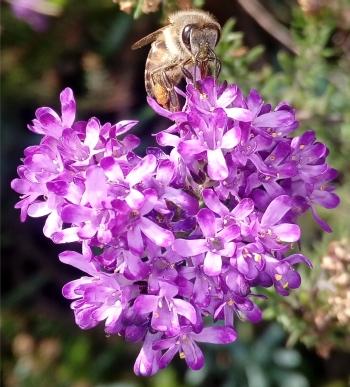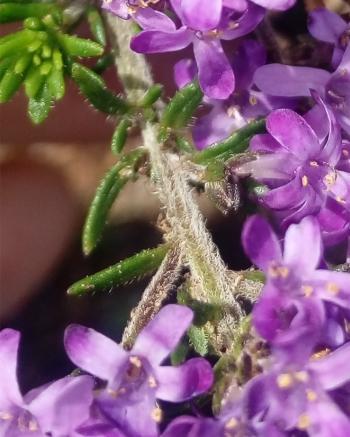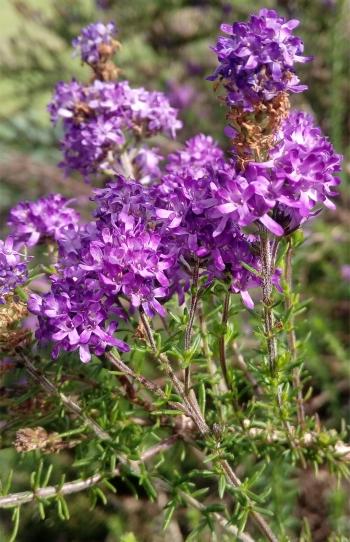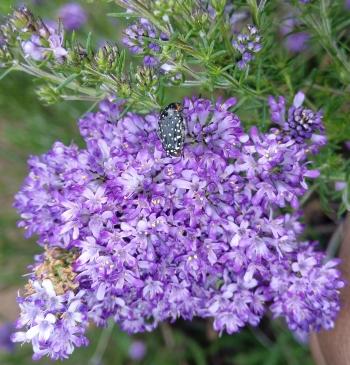Selago villicaulis ‘Purple Turtle’
Selago villicaulis Rolfe ‘Purple Turtle’
Family: Scrophulariaceae
Common names: purple turtle selago
Introduction
This is a low growing perennial with striking lavender flowers, which appear twice in a year, in midwinter to spring and in midsummer, and sporadically in between.

Description
Description
Selago villicaulis is a multi-branched perennial that grows up to 400 mm high. The stem is green and has visible fine, soft hairs.

The leaves occur in characteristic whorls, and are small, narrow, glossy and have soft hairs on the margins.

Flowers can be seen occurring in compact clusters at the top of multiple shoots of the branches. Each flower is small with a narrow tube that opens into 5 petals, showing a striking lavender colour, with purple tinges.

The main flowering period occurs in autumn until spring, but flowers are seen on the plants nearly all year round.
‘Purple Turtle’, a cultivar developed at Kirstenbosch National Botanical Garden, is a more compact and darker-flowered form of Selago villicaulis. It was developed through a process of focused selecting over a number of generations of seedlings raised in the garden from seed collected near Brenton-on-Sea.
Conservation Status
Status
According to the Red List of South African plants website the conservation status of this species is Vulnerable (VU). This is because of the ongoing coastal development on the south coast, as well as alien plant invasion in its habitat.
Distribution and habitat
Distribution description
Selago villicaulis is endemic to the Western Cape Province of South Africa, and is found growing only from Still Bay to Knysna, in Sand Fynbos and Dune Fynbos, on sandy slopes and limestone. The habitat consists of fixed dunes of up to 150 m tall in the lower slopes. The natural habitat has a Mediterranean climate, with moderately hot summers, and mild to chilly winters. It is one of the highest rainfall areas in South Africa. Most of the rains occur in the winter months, brought on by the humid sea-winds from the Indian Ocean. Due to its natural habitat, this plant can tolerate mild frost and moderately acidic soils, as well as alkaline soils.
Derivation of name and historical aspects
History
The genus Selago was first described by the Swedish-born naturalist Carolus Linnaeus, in 1753. The genus name is made up of 2 words; sel which means ‘sight’ and jach which means ‘salutary’ and ‘beneficial’ which refers to its medicinal properties. However, another source suggests that the derivation of the name selagh is Greek and means ‘flashing’, but that allusion is still unclear. The species name villicaulis means ’with hairy stems’. The cultivar name ‘Purple Turtle’ was coined as a trade name for it, by Kirstenbosch horticulturist, Adam Harrower.
Selago used to be placed in the small family Selaginaceae, but is now part of the Scrophulariaceae, the large snapdragon/figworts family, which consists mostly of herbs or sometimes small shrubs comprising about 190 genera and 5 100 species worldwide, of which 825 of those are native to southern Africa.

Ecology
Ecology
Butterflies and bees are attracted by the bright flowers, which are available for a long period, thereby transferring pollen to the stigmas. The seeds form in stages because some parts of the plant finish flowering earlier than others, resulting in seeds ripening at different periods. They are dispersed by wind after dehiscing.
Uses
Use
There are no medicinal uses that have been associated with this plant. However, it makes a stunning ornamental in a flower bed, as it displays flowers over a long period. Its soft texture brings a balance of contrast in the garden. In Kirstenbosch National Botanical Garden this is portrayed by planting companion plants, such as Paranomus reflexus, Leucospermum praecox and L. calligerum.
Growing Selago villicaulis ‘Purple Turtle’
Grow
Selago villicaulis is a fast growing plant which can be planted in a full sun position with rich but well-draining soil. ‘Purple Turtle’ performs well in most garden situations, in good light. To achieve a neat and compact habit, and good flowering, prune the plant back after flowering to initiate new shoots from the base, and it will start flowering again in a few months. Plants live for 3-4 years on average before they need to be re-propagated. It is not known if 'Purple Turtle' is frost hardy, but considering its native habitat it is probably not.
It can be easily grown from seeds and cuttings. Sow seeds in autumn. Sow thinly in a well-draining soil or in a layer of fine river sand over normal potting soil. The seed is fine so it is best to mix the seed with a small quantity of fine, dry sand and spread it evenly over the soils surface. It is not necessary to cover the seed, but a very thin layer of fine sand won’t harm. Treat the surface with a fine layer of cinnamon powder to prevent fungal infections and damping off. Water very lightly so as not to disturb the seeds. Place in a shaded area amd keep moist and warm (not hot) and germination should take 2-4 weeks.Prick out and pot up when they are large enough.
Take softwood or semi-hardwood cuttings in spring or early summer, from the soft new growth of the plant. Apply softwood rooting hormone to encourage quick growth, insert cutting in well-draining rooting medium and place on a warm surface. Placing the cuttings in a propagation unit with bottom heat and intermittent mist will speed up the rooting process, but is not essential.
References
- Clarke, H. & Charters, M. 2016. The illustrated dictionary of southern African plant names. Flora & Fauna Publications Trust, Jacana, Johannesburg.
- Carr, G.D. 2006. Scrophulariaceae. University of Hawaii, Botany Department.
- Goldblatt, P. & Manning, J. 2000. Cape Plants. A conspectus of the Cape flora of South Africa. Strelitzia 9. National Botanical Institute, Pretoria & Missouri Botanical Garden, Missouri.
- Raimondo, D. et al. 2009. Red list of South African plants. Strelitzia 25. SANBI (South African National Biodiversity Institute), Pretoria.
- Rolfe, R.A. 1901. Selagineae. In W.T. Thiselton-Dyer (ed). Flora capensis V Section I (Acanthaceae–Proteaceae): 95–180. Lovell Reeve, London.
Credits
Sinikeziwe Ncaphayi
Kirstenbosch National Botanical Garden
September 2018
Acknowledgments: The author thanks Adam Harrower for sharing his experience in selecting and propagating this plant.
Plant Attributes:
Plant Type: Perennial, Shrub
SA Distribution: Western Cape
Soil type: Sandy, Loam
Flowering season: Spring, Late Summer, Winter, Sporadic/All year
PH: Acid, Alkaline, Neutral
Flower colour: Purple, Mauve/Lilac
Aspect: Full Sun
Gardening skill: Easy
Special Features:
Horticultural zones










Rate this article
Article well written and informative
Rate this plant
Is this an interesting plant?
Login to add your Comment
Back to topNot registered yet? Click here to register.